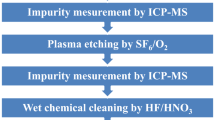Abstract
This paper presents Thermal Laser Separation (TLS) as a novel dicing technology for silicon carbide (SiC) wafers. Results of this work will play an important role in improving the SiC dicing process regarding throughput and edge quality. TLS process parameters were developed for separating 4H-SiC wafers. Separated SiC dies were analyzed and compared with results produced with current state of the art blade dicing technology. For the first time, fully processed 100 mm 4H-SiC wafers with a thickness of 450 μm, including epi-layer and back side metal layers, could be separated with feed rates up to 200 mm/s. Besides the vastly improved dicing speed, the TLS separation process results in two important features of the separated SiC devices: First, edges are free of chipping and therefore of higher quality than the edges produced by blade dicing. Second, the TLS process is kerf free, which allows for reducing the necessary dicing street width and hence increasing the number of devices per wafer.
Similar content being viewed by others
References
T. Sudarshan; Materials Science and Engineering of Bulk Silicon Carbides; Zhe Chuan Feng (Ed.) in SiC Power Materials, Devices and Applications, Springer-Verlag Berlin, Heidelberg, New York, pp. 1–61, 2004
C.-M. Zetterling and M. Östling; Advantages of SiC; C.-M. Zetterling (Ed.) in Process Technology for Silicon Carbide Devices, EMIS processing series 2, IEE, INSPEC, London, 2002
J. L. Hudgins; Wide and Narrow Bandgap Semiconductors for Power Electronics: A New Valuation; J. Elect. Mat. 32(6), 471, 2003
T. P. Chow and R. Tyagi; Wide Bandgap Compound Semiconductors for Superior High Voltage Unipolar Power Devices; IEEE Trans. ED 41, 1481, 1994
M. Bhatnagar and B. J. Baliga; Comparison of 6H-SiC, 3C-SiC, and Si for Power Devices; IEEE Trans. ED 40, 645, 1993
Z. Luo, T. chen, D. C. Sheridan, and J. D. Cressler; 4H-SiC Power-Switching Devices for Extreme-Environment Applications; Zhe Chuan Feng (Ed.) in SiC Power Materials, Devices and Applications, Springer-Verlag Berlin, Heidelberg, New York, pp. 375–409, 2004
Y. Goldberg, M. Levinshtein, S. Rumyantsev; Properties of Advanced Semiconductor Materials GaN, AlN, SiC, BN, SiC, SiGe; John Wiley & Sons; New York, pp. 93–148, 2001
H.-U. Zühlke; Thermal laser separation for wafer dicing; Solid State Technology, 2009
O. Haupt; Abtragsfreies Trennen von kristallinem Silizium mit kontinuierlicher Laserstrahlung; Dissertation, Gottfried Wilhelm Leibniz Universität Hannover, 2009
H. Wallner; Linienstrukturen an Bruchflächen; Zeitschrift für Physik, vol. 114, pp. 368–378, 1939
D. Hull; Fractography–Observing, Measuring and Interpreting Fracture Surface Topography; Cambridge University Press, 1999
Acknowledgments
The authors would like to thank our partners from Infineon who provided test wafers as well as fruitful discussions.
Author information
Authors and Affiliations
Rights and permissions
About this article
Cite this article
Lewke, D., Koitzsch, M., Schellenberger, M. et al. Ablation Free Dicing of 4H-SiC Wafers with Feed Rates up to 200 mm/s by Using Thermal Laser Separation. MRS Online Proceedings Library 1433, 37–42 (2012). https://doi.org/10.1557/opl.2012.1035
Published:
Issue Date:
DOI: https://doi.org/10.1557/opl.2012.1035




